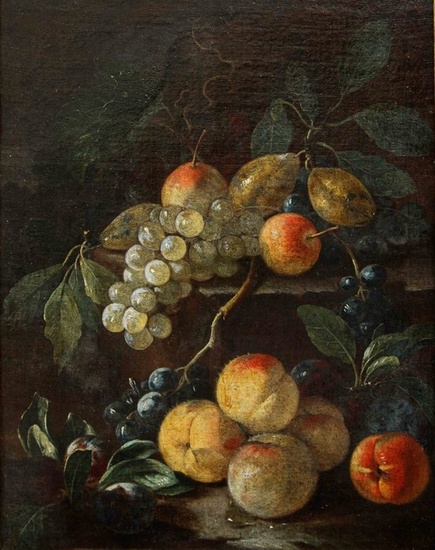Giovan Battista Ruoppolo (1626-1693), Ambito di - Natura morta di frutti
Neapolitan school, 17th century
Still life of fruits
Oil on canvas, 38 x 48 cm - With frame, 62 x 51 cm
\r
The present still life develops vertically, following the format of the canvas: on a shelf, whose presence can be understood only by a small reflection that breaks the dim light, are placed some yellow apples flecked with an intense red. On a cake stand there is a bunch of white grapes, some lemons and a couple more apples. The compositional structure is innervated along a diagonal that develops from the upper right corner with the lemon leaves and descends to the lower left corner through the small branch of black grapes to culminate with other slightly withered leaves including a plum is also hidden. The pictorial drafting is evidently delicate as can be seen from the delicate tonal passages that describe leaves and fruits, which emerge from the dim light but without violent chiaroscuro contrasts. These characteristics refer to the still life painting of the Neapolitan context of the seventeenth century of which Luca Forte (1600/1605-before 1670) , Paolo Porpora (1617-1673) , Giovan Battista Ruoppolo (1626-1693) and Giuseppe Ruoppolo (1630- 1710) as well as members of the Recco family.
The painting in question finds greater similarities in the works of Giovan Battista Ruoppolo and his circle as demonstrated by the comparison with Flowers and Vegetables at the Ashmolean Museum in Oxford in which the same play of reflections on the shelf is present. On a compositional level, the descending and diagonal trend of the bunches and other fruits recalls that of Still Life with Flowers in a Private Collection.
That the author of the still life in question falls within the circle of Giovan Battista Ruoppolo can also be demonstrated by comparison with the works of one of his students, Aniello Ascione (1680-1708) : for example in Still life of fruits in the Capodimonte Museum in Naples, similarities can be found in the yield of grapes, apples and pears. However, Still Life of grapes, figs and pomegranate, in the Private Collection, presents a diagonal development similar to that of the present canvas.
View it on
Estimate
Time, Location
Auction House
Neapolitan school, 17th century
Still life of fruits
Oil on canvas, 38 x 48 cm - With frame, 62 x 51 cm
\r
The present still life develops vertically, following the format of the canvas: on a shelf, whose presence can be understood only by a small reflection that breaks the dim light, are placed some yellow apples flecked with an intense red. On a cake stand there is a bunch of white grapes, some lemons and a couple more apples. The compositional structure is innervated along a diagonal that develops from the upper right corner with the lemon leaves and descends to the lower left corner through the small branch of black grapes to culminate with other slightly withered leaves including a plum is also hidden. The pictorial drafting is evidently delicate as can be seen from the delicate tonal passages that describe leaves and fruits, which emerge from the dim light but without violent chiaroscuro contrasts. These characteristics refer to the still life painting of the Neapolitan context of the seventeenth century of which Luca Forte (1600/1605-before 1670) , Paolo Porpora (1617-1673) , Giovan Battista Ruoppolo (1626-1693) and Giuseppe Ruoppolo (1630- 1710) as well as members of the Recco family.
The painting in question finds greater similarities in the works of Giovan Battista Ruoppolo and his circle as demonstrated by the comparison with Flowers and Vegetables at the Ashmolean Museum in Oxford in which the same play of reflections on the shelf is present. On a compositional level, the descending and diagonal trend of the bunches and other fruits recalls that of Still Life with Flowers in a Private Collection.
That the author of the still life in question falls within the circle of Giovan Battista Ruoppolo can also be demonstrated by comparison with the works of one of his students, Aniello Ascione (1680-1708) : for example in Still life of fruits in the Capodimonte Museum in Naples, similarities can be found in the yield of grapes, apples and pears. However, Still Life of grapes, figs and pomegranate, in the Private Collection, presents a diagonal development similar to that of the present canvas.



